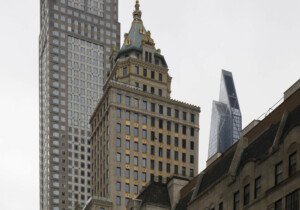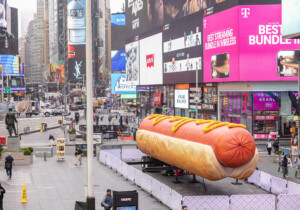Besides the overcrowded L and the overabundance of Starbucks/Chase Banks, one of New York‘s favorite things to kvetch about is the rent: it’s too damn high. Now, through Wage Island, an installation created by a New York–based interaction and information designer, it’s possible to see in 3D how much housing really costs in this city.
Ekene Ijeoma‘s Wage Islands sprang from the designer’s conversations with Fast Food Forward, a labor advocacy organization that’s pushing for a higher minimum wage for fast food workers. Compelled by the group’s commentary on how difficult it is for minimum wage workers to pay for housing, Ijeoma put his designer’s training to work, correlating median monthly housing costs of each neighborhood with the amount one would have to earn to afford to live there.
“This created a poetic way of creating empathy between minimum wage workers and citizens they serve; making the issue about everyone,” Ijeoma mused. He collaborated with a team of six to execute the GIS modeling of New York City, design and build the model, and program the Arduino board that controls the islands’ topography.
Wage Islands was commissioned for Measure, the Storefront for Art and Architecture’s exhibition that ran from August 14 through September 19, 2015. The map’s elevations are comprised of over 500 pieces of laser-cut acrylic. Elevations are derived from median monthly housing costs in different neighborhoods, with $271 on the low end and $4,001 at the top.
The islands are situated in a tray filled with blue-black water. The user can adjust the amount of water in the box by scaling wages up from the city minimum of $8.75 per hour to a high of $77 per hour. The tallest peaks represent the most affordable neighborhoods; those who make at least $77 per hour have the luxury to choose Manhattan’s tony Tribeca or Brooklyn’s Brownsville, one of the city’s poorest neighborhoods.
Precision, and reflection on the real world factors that go into determining affordability, is scuttled in favor of highly evocative representation. New York is a renter’s city: Less than a third of residents own their own homes.
When asked what data was used to gauge median rents, Ijeoma explained that “this was more about looking at New York City together and not separating the different neighborhoods and people from the larger issue.”
He used the American Community Survey’s (ACS) median monthly housing costs as a stand-in for median rents, although ACS data covers both housing costs incurred by homeowners and renters. 69 percent of New Yorkers rent, not own, so the choice to rely on this ACS dataset is unclear. The American Housing Survey, however, has fine-grained data on renters for major metro areas.)
Like Fannie and Freddie, Ijeoma pegs affordability to spending no more than 30 percent of one’s income on housing. That’s sensible advice, but more than half of New Yorkers are, by this measure, rent burdened, spending over 30 percent of their income on rent.
Affordability guidelines are generally broken down by the number of bedrooms per unit as a proxy for household size. Instead of looking at average rents across neighborhoods, or rents for units of one particular size, Ijeoma dismissed those nuances as irrelevant for this project, as “[the data] would’ve more or less looked the same because of the geo-spatial interpolation and translation into 3D.”










